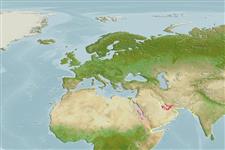Actinopterygii (ray-finned fishes) >
Perciformes (Perch-likes) >
Trichonotidae (Sanddivers)
Etymology: Trichonotus: Greek, thrix = hair + Greek, noton = back (Ref. 45335). More on author: Randall.
Environment / Climate / Range
Ecology
Marine; demersal; depth range 0 - 2 m (Ref. 10682). Tropical, preferred ?
Western Indian Ocean: Persian Gulf to southern Oman.
Size / Weight / Age
Maturity: Lm ? range ? - ? cm
Max length : 14.5 cm TL male/unsexed; (Ref. 11441)
Dorsal
spines
(total): 3 - 4;
Dorsal
soft rays
(total): 44-47;
Anal
spines: 1;
Anal
soft rays: 36 - 39;
Vertebrae: 52 - 54. Females with an indistinct narrow dark stripe on body above lateral line and no black on anterior part of dorsal fin; males with a longitudinal row of 14 brown spots and 3 rows of small, dark edged, pale blue spots on body; dorsal and anal fins with a row of yellow dots on each membrane.
Feeds on zooplankton about half a meter above the sand substratum (Ref. 10682).
Life cycle and mating behavior
Maturity | Reproduction | Spawning | Eggs | Fecundity | Larvae
Randall, J.E. and A.B. Tarr, 1994. Trichonotus arabicus (Perciformes: Trichonotidae), a new species of sand diver from the Arabian Gulf and Oman. Fauna of Saudi Arabia 14:309-316. (Ref. 10682)
IUCN Red List Status (Ref. 115185)
CITES (Ref. 94142)
Not Evaluated
Threat to humans
Harmless
Human uses
More information
Common namesSynonymsMetabolismPredatorsEcotoxicologyReproductionMaturitySpawningFecundityEggsEgg development
Age/SizeGrowthLength-weightLength-lengthLength-frequenciesMorphometricsMorphologyLarvaeLarval dynamicsRecruitmentAbundance
ReferencesAquacultureAquaculture profileStrainsGeneticsAllele frequenciesHeritabilityDiseasesProcessingMass conversion
Tools
Special reports
Download XML
Internet sources
Estimates of some properties based on models
Phylogenetic diversity index (Ref.
82805): PD
50 = 0.5020 [Uniqueness, from 0.5 = low to 2.0 = high].
Bayesian length-weight: a=0.00389 (0.00180 - 0.00842), b=3.12 (2.94 - 3.30), in cm Total Length, based on all LWR estimates for this body shape (Ref.
93245).
Trophic Level (Ref.
69278): 3.4 ±0.45 se; Based on food items.
Resilience (Ref.
69278): .
Vulnerability (Ref.
59153): Low vulnerability (10 of 100) .
